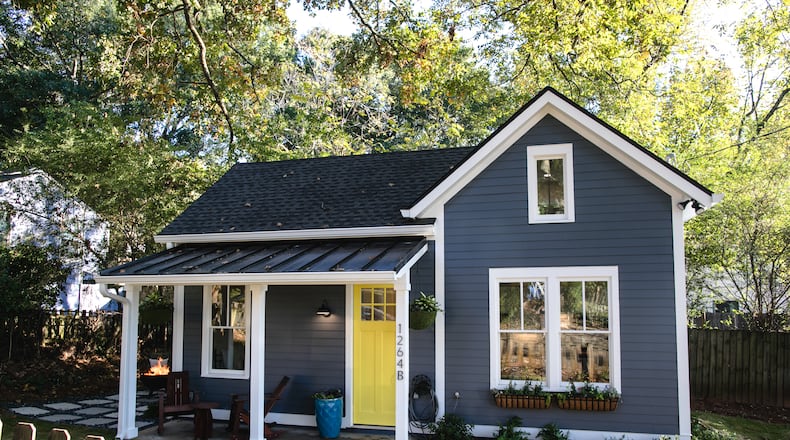After 12 years as owners of Porter Beer Bar, Molly Gunn and her husband, Nick Rutherford, recently turned their efforts to real estate investing. The couple had acquired six single-family rentals since they began investing in 2017, but after 2021, it no longer made sense to invest in single-family homes, Gunn said in a recent interview.
They wanted a safe way to use their existing properties to create positive cash flow, so in November 2022, Gunn built the first accessory dwelling unit (ADU) on one of their rental properties and is now in the process of building two more on their other rental lots.
I heard this story when I reached out to David Melton, business development manager at ATL ADU, which provides full-service ADU planning. The company launched in 2017, when zoning changes made Atlanta more ADU-friendly.
Gunn is a client of ATL ADU, and as soon as Melton posted her story online, he got phone calls from people asking how they could rent one of Gunn’s ADUs. “Clearly there is a demand for it,” Melton said.
I’ve written about Atlanta’s housing challenges before, including the predatory corporations that have gobbled up properties in neighborhoods across the metro area as well as the rental regulations that favor landlords over tenants.
The idea that ADUs could play a role in alleviating Atlanta’s affordable housing crisis is one worth considering, but it also means changing our beliefs about what a residential neighborhood should look like while also expanding funding sources that would put ADUs in reach of all homeowners.
An ADU is a home with its own kitchen and bathroom. It can be attached to the primary house or garage, or it can be a separate structure. In the city of Atlanta, ADUs are limited to 750 square feet and 20 feet in height. They are only allowed in certain zones and must adhere to specific setbacks in each zone.
ADUs have many positives. They are suited to intergenerational living and can allow elderly residents to age in place even as neighborhoods gentrify. They provide income to homeowners who can keep rental costs low since they already own the land. They give renters the opportunity to live in a community they may not otherwise be able to afford. Innovative placement of ADUs – many are not visible from the street – can create extra housing without significantly changing the character of a neighborhood.
But there are also barriers to entry.
“One of the biggest barriers to providing housing is discriminatory and exclusionary zoning,” said Eric Kronberg, principal at Kronberg Urbanists and Architects. Though organizations like AARP have been lobbying for ADUs for 20 years, ADUs have only been legal in Atlanta for six years. Currently, the only people building them are those who have access to $150,000 in cash or home equity.
“(The market) would be really exploding if ADUs were easier to finance,” Kronberg said.
ADUs can cost anywhere from $60,000 to more than $300,000. Anyone who wants to build an ADU cannot use a conventional mortgage loan. They must have cash on hand, do a cash-out refinance or borrow against their home’s equity.
Sheri Koones, author of “Prefabulous for Everyone” (Gibbs Smith, $37) said prefab housing is a little less expensive than building on site, is quickly built and can be a more viable option for people who don’t have access to a lot of cash.
Credit: Sherri Koones
Credit: Sherri Koones
“ADUs have become one of the fastest-growing home types in the country,” Koones said.
California, Florida, Texas and Georgia account for half of the 1.4 million ADUs across the country, according to 2020 research from Freddie Mac. About 70% of single-family zoning in the city of Atlanta allows for ADUs.
In 2021, Groundfloor, a real estate crowdfunding platform, introduced a pilot program designed to spur the development of ADUs in metro Atlanta. The effort helped to fund at least three ADUs.
That same year, Kronberg was among the locals pushing the city to pass an ordinance that would allow homeowners to sell an ADU separately from the primary dwelling. “That would open up financial solutions,” he said. But the effort didn’t move forward.
Kronberg said we need to make the construction of affordable housing more accessible to people across a range of incomes.
Historically, single-family zoning in Atlanta has erred on the side of uniformity, Melton said. No one wants to live in a single-family neighborhood and wake up with a bar as a next-door neighbor, but there is also a very specific type of housing that is allowed which paves the way for a specific type of person to live there, he said.
Financing is an issue for ADUs, but for some of us, the fear of change is an even greater foe.
We won’t find our way out of this housing crisis without considering all possibilities, and ADUs could be another tool to help us reimagine communities in nontraditional, yet supportive ways.
As Kronberg quipped, “No one has ever been killed by an ADU.”
Read more on the Real Life blog (www.ajc.com/opinion/real-life-blog/) and find Nedra on Facebook (www.facebook.com/AJCRealLifeColumn) and Twitter (@nrhoneajc) or email her at nedra.rhone@ajc.com.
About the Author
Keep Reading
The Latest
Featured





